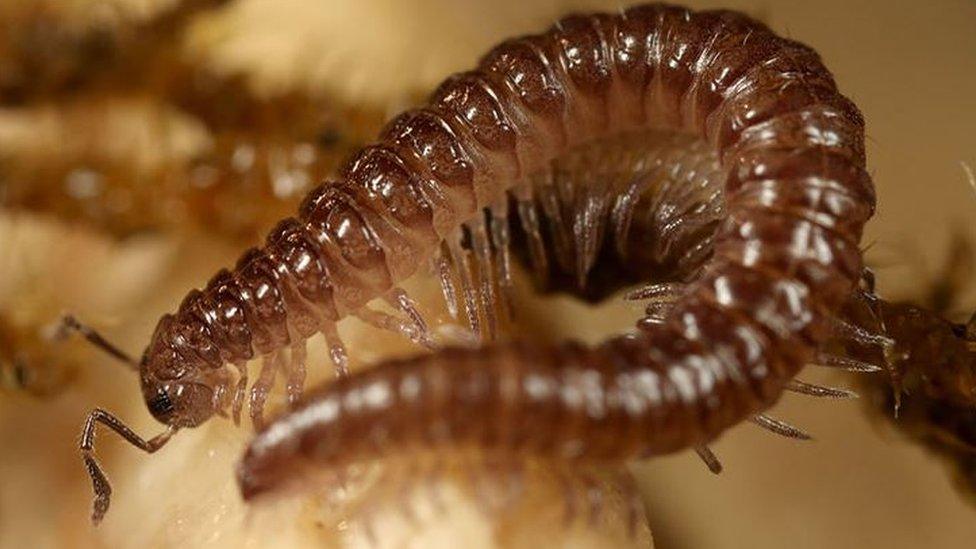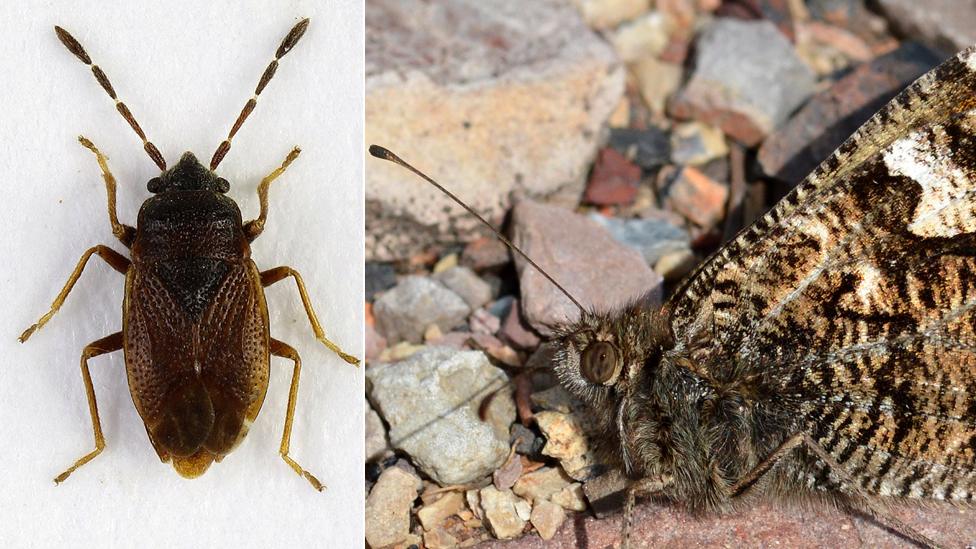Biodiversity: 'Beast of Beddau' is new millipede find
- Published
A walk with Liam Olds, who led the research, says there is plenty to see
The Beast of Beddau has joined the Maerdy Monster as a new bug species found at old coal mine sites in the UK.
The small, white millipede is one of more than 900 different species found during a three-year study which highlights the importance of colliery spoil sites in south Wales to wildlife.
It was found at the old Cwm Colliery near Beddau, described as one of the most biodiverse in the region.
Researchers had already discovered the 12mm-long Maerdy Monster.

Entomologist Liam Olds, who led the research, says there is plenty to see on a walk around the old sites
This was believed to have been the first millipede species found in the UK since 1993.
But at only 5mm long, the Beast of Beddau - found about 13 miles (21km) from the earlier discovery - is half the size. It was found underneath stones by naturalist Christian Owen - who also found the Maerdy Monster.
The "Beast" has seven or eight lenses in its eyes - unlike the six found in a similar species. Scientists in Canada examined its genes as part of the research.

The Maerdy Monster is about twice the length of the Beast of Beddau
Altogether, surveys were conducted across 15 colliery spoil sites , external- eight in Rhondda Cynon Taf and seven in Neath Port Talbot - between 2015 and 2018.
Spoil from old coal mines is low in nutrients but researchers found the earth can be quite complex and allow lichen-heath and even wetland habitat to develop.
But it is still widely seen as derelict land, suitable only for reclamation, re-development or tree-planting.
Liam Olds, the insect expert behind the research, said colliery spoil sites were becoming an "increasingly important refuge" for species declining in the wider countryside.
"On a single colliery site you can have anything from woodland, to flower-rich grassland, lakes, ponds and reed beds - providing the variety needed for insects to complete their life cycle," he said.
The tips had become "little islands where biodiversity can thrive."

The study found nearly 200 different invertebrate species which were rare enough to be classed as conservation priorities.
Ninety bee species were identified - including aptly-named mining bees - 13 dragonfly species and 28 types of butterfly.
Some of the colliery sites surveyed had been reclaimed, others had been left to grow wild.
The research was supported by Neath Port Talbot and Rhondda Cynon Taf councils, the National Museum of Wales, the Wildlife Trusts of South and West Wales, and Buglife Cymru.
Clare Dinham, Buglife Cymru's director, said a change in attitude towards the tips was now needed.
"Unfortunately the public, councils and Welsh Government don't necessarily have the greatest perception of brownfield sites," she said.
"They are seen as areas we should develop, saving greener areas that might be biodiversity deficient.
"So this report is going to be really important for us to highlight their importance across Wales and the UK."
Iconic and notable species found

Dingy skipper (Erynnis tages) is classed as an iconic species, a butterfly in decline but found on reclaimed and old spoil tips

Red-backed mining bee (Andrena similis) - a scarce insect associated with gorse-clad slopes of old, re-vegetated tip sites

This is Larinus carlinae - a weevil associated with thistles and a species never found in the south Wales area before

Acompus rufipes - this is a ground bug, classed as a notable species and found in south Wales for the first time

Small pearl-bordered fritillary - Boloria selene - is a species of butterfly in decline and likes marshy areas of tip sites where violets grow

Green tiger beetle (Cicindela campestris) - is agile and quick and likes hunting other bugs on sparsely vegetated, sunny banks at colliery tips

The drymus pumilo – a ground bug - is new to the region, while the Grayling butterfly (right) is in decline but is the most iconic species for colliery spoil habitats
- Published26 March 2019

- Published27 March 2017

- Published7 March 2019

- Published27 February 2019
